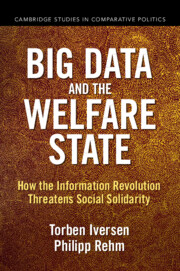49 results
Copyright page
-
- Book:
- Big Data and the Welfare State
- Published online:
- 25 May 2022
- Print publication:
- 19 May 2022, pp iv-iv
-
- Chapter
- Export citation
Appendix 5C: - The Relationship between Income and Default Risk
- from 5 - Credit Markets
-
- Book:
- Big Data and the Welfare State
- Published online:
- 25 May 2022
- Print publication:
- 19 May 2022, pp 141-147
-
- Chapter
- Export citation
Appendix 5B: - The Effect of a Flat-Rate Benefit on the Distribution of Default Risks
- from 5 - Credit Markets
-
- Book:
- Big Data and the Welfare State
- Published online:
- 25 May 2022
- Print publication:
- 19 May 2022, pp 141-141
-
- Chapter
- Export citation
Appendix 2.2: - Satisfying the Insurer’s Balanced Budget Constraint
- from 2 - Theoretical Framework
-
- Book:
- Big Data and the Welfare State
- Published online:
- 25 May 2022
- Print publication:
- 19 May 2022, pp 42-43
-
- Chapter
- Export citation
Dedication
-
- Book:
- Big Data and the Welfare State
- Published online:
- 25 May 2022
- Print publication:
- 19 May 2022, pp v-vi
-
- Chapter
- Export citation
Contents
-
- Book:
- Big Data and the Welfare State
- Published online:
- 25 May 2022
- Print publication:
- 19 May 2022, pp vii-vii
-
- Chapter
- Export citation
7 - Conclusion
-
- Book:
- Big Data and the Welfare State
- Published online:
- 25 May 2022
- Print publication:
- 19 May 2022, pp 188-203
-
- Chapter
- Export citation
1 - Introduction
-
- Book:
- Big Data and the Welfare State
- Published online:
- 25 May 2022
- Print publication:
- 19 May 2022, pp 1-14
-
- Chapter
- Export citation
Tables
-
- Book:
- Big Data and the Welfare State
- Published online:
- 25 May 2022
- Print publication:
- 19 May 2022, pp x-xi
-
- Chapter
- Export citation
5 - Credit Markets
-
- Book:
- Big Data and the Welfare State
- Published online:
- 25 May 2022
- Print publication:
- 19 May 2022, pp 105-158
-
- Chapter
- Export citation
Index
-
- Book:
- Big Data and the Welfare State
- Published online:
- 25 May 2022
- Print publication:
- 19 May 2022, pp 219-232
-
- Chapter
- Export citation
Appendix 2.1: - Graphical Representation of the Pooled Equilibrium with Private Information and Adverse Selection
- from 2 - Theoretical Framework
-
- Book:
- Big Data and the Welfare State
- Published online:
- 25 May 2022
- Print publication:
- 19 May 2022, pp 40-41
-
- Chapter
- Export citation
4 - Private Markets for Life and Health Insurance
-
- Book:
- Big Data and the Welfare State
- Published online:
- 25 May 2022
- Print publication:
- 19 May 2022, pp 70-104
-
- Chapter
- Export citation
Appendix 5D: - Regression Discontinuity Results
- from 5 - Credit Markets
-
- Book:
- Big Data and the Welfare State
- Published online:
- 25 May 2022
- Print publication:
- 19 May 2022, pp 148-158
-
- Chapter
- Export citation
6 - Labor Market Risks
-
- Book:
- Big Data and the Welfare State
- Published online:
- 25 May 2022
- Print publication:
- 19 May 2022, pp 159-187
-
- Chapter
- Export citation
3 - A Brief Analytical History of Social Protection
-
- Book:
- Big Data and the Welfare State
- Published online:
- 25 May 2022
- Print publication:
- 19 May 2022, pp 44-69
-
- Chapter
- Export citation
Appendix 5A: - The Model
- from 5 - Credit Markets
-
- Book:
- Big Data and the Welfare State
- Published online:
- 25 May 2022
- Print publication:
- 19 May 2022, pp 141-141
-
- Chapter
- Export citation
Acknowledgments
-
- Book:
- Big Data and the Welfare State
- Published online:
- 25 May 2022
- Print publication:
- 19 May 2022, pp xii-xiv
-
- Chapter
- Export citation

Big Data and the Welfare State
- How the Information Revolution Threatens Social Solidarity
-
- Published online:
- 25 May 2022
- Print publication:
- 19 May 2022
References
-
- Book:
- Big Data and the Welfare State
- Published online:
- 25 May 2022
- Print publication:
- 19 May 2022, pp 204-218
-
- Chapter
- Export citation



